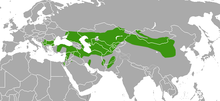Vormela peregusna
| Marbled polecat | |
|---|---|
 |
|
| Adult marbled polecat (Vormela peregusna) | |
| Scientific classification | |
| Kingdom: | Animalia |
| Phylum: | Chordata |
| Class: | Mammalia |
| Order: | Carnivora |
| Family: | Mustelidae |
| Subfamily: | Mustelinae |
| Genus: |
Vormela Blasius, 1884 |
| Species: | V. peregusna |
| Binomial name | |
|
Vormela peregusna (Güldenstädt, 1770) |
|
 |
|
| Marbled polecat range | |
The marbled polecat (Vormela peregusna) is a small mammal belonging to the monotypic genus Vormela within the Mustelinae subfamily. Vormela is from the German word Würmlein, which means "little worm". The term peregusna comes from perehuznya, which is Ukrainian for polecat. Marbled polecats are generally found in the drier areas and grasslands of southeastern Europe to western China. Like other members of Mustelinae, it can emit a strong-smelling secretion from anal sacs under the tail when threatened.
Ranging in length from 29–35 cm (head and body), the marbled polecat has a short muzzle and very large, noticeable ears. The limbs are short and claws are long and strong. While the tail is long, with long hair, the overall pelage is short. Black and white mark the face, with a black stripe across the eyes and white markings around the mouth. Dorsally, the pelage is yellow and heavily mottled with irregular reddish or brown spots. The tail is dark brown with a yellowish band in the midregion. The ventral region and limbs are a dark brown. Females weigh from 295 to 600 g, and males can range from 320 to 715 g.
The marbled polecat is found from southeast Europe to Russia and China. Its range includes Bulgaria, Georgia, Turkey, Romania, Asia Minor, Lebanon, Syria, Jordan, Israel, Palestine, Armenia, Azerbaijan, Iran, Afghanistan, north-western Pakistan, Yugoslavia, Mongolia, China, Kazakhstan and north to the Altai Steppes in Siberia. In 1998, a marbled polecat was recorded on the Sinai Peninsula, Egypt.
...
Wikipedia

